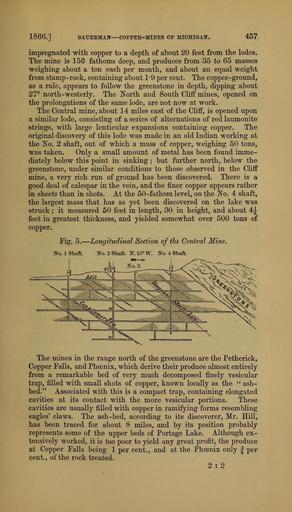MAKE A MEME
View Large Image

| View Original: | The_Quarterly_journal_of_the_Geological_Society_of_London_(13935560091).jpg (1170x2049) | |||
| Download: | Original | Medium | Small | Thumb |
| Courtesy of: | commons.wikimedia.org | More Like This | ||
| Keywords: The Quarterly journal of the Geological Society of London (13935560091).jpg 1866 <br> BATJERMAN COPPER-MINES OP MICHIGAN <br> 457 <br> impregnated with copper to a depth of about 20 feet from the lodes <br> The mine is 156 fathoms deep and produces from 35 to 65 masses <br> weighing about a ton each per month and about an equal weight <br> from stamp-rock containing about 1-9 per cent The copper-ground <br> as a rule appears to follow the greenstone in depth dipping about <br> 27┬░ north-westerly The North and South Cliif mines opened on <br> the prolongations of the same lode are not now at work <br> The Central mine about 14 miles east of the Cliff is opened upon <br> a similar lode consisting of a series of alternations of red laumonite <br> strings with large lenticular expansions containing copper The <br> original discovery of this lode was made in an old Indian working at <br> the 'No 2 shaft out of which a mass of copper weighing 50 tons <br> was taken Only a small amount of metal has been found imme- <br> diately below this point in sinking ; but further north below the <br> greenstone under similar conditions to those observed in the Cliff <br> mine a very rich run of ground has been discovered There is a <br> good deal of calcspar in the vein and the finer copper appears rather <br> in sheets than in shots At the 50-fathom level on the No 4 shaft <br> the largest mass that has as yet been discovered on the lake was <br> struck ; it measured 50 feet in length 30 in height and about 4 <br> feet in greatest thickness and yielded somewhat over 500 tons of <br> copper <br> Pig 5 ö Longitudinal Section of the Central Mine <br> No 1 Shaft No 2 Shaft N 15┬░ W No 4 Shaft <br> The mines in the range north of the greenstone are the Petherick <br> Copper PaUs and Phoenix which derive their produce almost entirely <br> from a remarkable bed of very much decomposed finely vesicular <br> trap filled with small shots of copper known locally as the ash- <br> bed Associated with this is a compact trap containing elongated <br> cavities at its contact with the more vesicular portions These <br> cavities are usually filled with copper in ramifying forms resembling <br> eagles' claws The ash-bed according to its discoverer Mr Hill <br> has been traced for about 8 miles and by its position probably <br> represents some of the upper beds of Portage Lake Although ex- <br> tensively worked it is too poor to yield any great profit the produce <br> at Copper Palls being 1 per cent and at the Phoenix only per <br> cent of the rock treated <br> 2i2 36164904 111477 51125 Page 457 Text v 22 http //www biodiversitylibrary org/page/36164904 1866 Geological Society of London Biodiversity Heritage Library The Quarterly journal of the Geological Society of London v 22 1866 Geology Periodicals Smithsonian Libraries bhl page 36164904 dc identifier http //biodiversitylibrary org/page/36164904 smithsonian libraries Information field Flickr posted date ISOdate 2014-04-21 Check categories 2015 August 26 CC-BY-2 0 BioDivLibrary https //flickr com/photos/61021753 N02/13935560091 2015-08-26 06 50 46 cc-by-2 0 PD-old-70-1923 The Quarterly journal of the Geological Society of London 1866 Photos uploaded from Flickr by F├” using a script | ||||